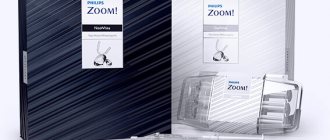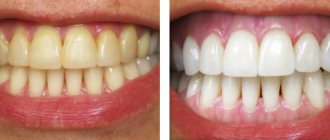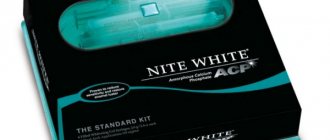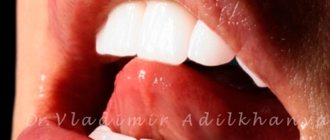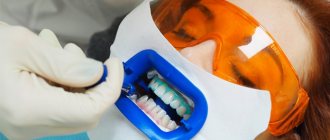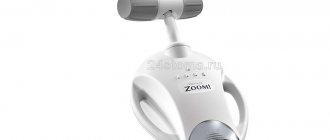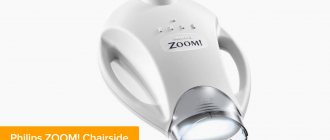Technology
The Zoom whitening procedure is based on the use of gels with a high content of hydrogen peroxide or carbamide peroxide. To activate such a drug, a special lamp is used, the main light spectrum of which is in the ultraviolet zone. Under the influence of light, the gel begins to heat up and release active oxygen ions, which penetrate deep into the dental tissues and destroy coloring pigments. As a result, the enamel acquires a beautiful natural white color.
Is this type of teeth whitening harmful? Subject to all safety rules and procedure technology, the dentist can guarantee the safety of manipulations and harmlessness to tooth enamel. But you can whiten with the Zoom system no more often than once every six months.
Before the whitening procedure, you must undergo a thorough examination by a dentist. If dental or gum disease is detected, it is necessary to undergo treatment and, in some cases, postpone the procedure until complete recovery. It is advisable to have the enamel professionally cleaned of tartar and other deposits within a few days. This will allow the gel to penetrate the tissue more actively and the lightening effect will be more pronounced.
The procedure itself with the preparatory stage takes 1.5-2 hours:
- Before whitening, the doctor determines the initial color of the enamel using the standardized VITA scale and discusses with the patient the shade that will be optimal for him.
- For the safety of the patient, before dental surgery, lips and cheeks are treated with a special cream with protection from ultraviolet radiation and fixed with a special retractor. It is mandatory to wear protective glasses on the patient's eyes to prevent burns.
- A composition is applied to the gums along the contour of the teeth, instantly hardening in air, which prevents the active gel from getting on the delicate mucous membranes.
- The gel is applied directly to the surface of the 10 upper and 10 lower teeth (“smile zone”) in an even, thin layer.
- A Zoom lamp is brought close to the teeth, which is fixedly fixed to a tripod. Its light falls exclusively on the bleached area.
- After 20 minutes, the remaining gel is carefully removed and the drug is applied again. The bleaching procedure is repeated. In total it includes 3 cycles.
- After the procedure is completed, the gel and protective substance are removed. A remineralizing solution is applied to the tooth enamel, which will help the teeth recover and reduce the likelihood of increased sensitivity.
Preparing for ZOOM whitening
In the absence of the above-mentioned contraindications to teeth whitening using ZOOM 3 technology, you should first make an appointment with a doctor for preliminary preparation, which includes the following steps:
- Treatment of teeth and gums when their diseases are detected.
- Professional oral hygiene with thorough removal of tartar and deposits on the enamel for better penetration of the whitening gel.
- Fluoridation to strengthen the enamel before the upcoming ZUM 3 teeth whitening procedure.
Additionally, the dentist can prescribe a course of enamel remineralization at home using special gels and pastes.
Advantages and disadvantages of the system
Photo whitening using Zoom technology has become widely known and widespread due to a large list of advantages :
- Teeth whitening is possible even in severe cases, when the darkening of the enamel is caused not only by drinking coffee or smoking, but also by taking antibiotics and fluorosis.
- It is possible to lighten the enamel by 8-12 tones, which is practically unattainable with other systems.
- You can restore the whiteness of your smile in one visit to the dentist’s office, since the procedure takes only 60 minutes.
- The effect lasts for 5 years.
Despite all the positive aspects listed above, this whitening system also has some disadvantages :
- The procedure may cause some discomfort and even pain in the patient due to heating of dental tissues under the influence of ultraviolet radiation.
- In case of accidental contact, the active gel has an aggressive effect on the soft tissues of the oral cavity.
- After whitening, increased sensitivity of tooth enamel to temperature and acid may persist for several days.
- In some cases, it is possible to develop a “over-whitening” effect, when teeth acquire an unnatural matte white color.
Contraindications for whitening
In order for the procedure to live up to expectations and not cause disappointment, and for the resulting effect to last for a long time, you should not get carried away with home whitening. It is advisable to immediately contact a dental clinic and follow simple recommendations:
- Before whitening using the Zoom 3 system, you should examine the oral cavity, remove possible inflammation, and cure caries.
- The doctor is obliged to check the degree of sensitivity of the teeth.
- If there are any contraindications, you should refrain from the procedure.
Restrictions for using Zoom 3 include:
- caries, wedge-shaped defects;
- prosthetic teeth and a large number of fillings;
- gum diseases and defects;
- increased sensitivity, thinned enamel;
- allergy to whitening preparations;
- taking medications that increase the sensitivity of tissues to light.
Who is the Zoom technology contraindicated for?
The Zoom system is by far the most modern technique. But even this is not suitable for all patients.
Main contraindications:
- patient age under 18 years;
- During pregnancy and breastfeeding;
- history of allergic reactions to substances used in teeth whitening;
- mental illness, epilepsy;
- defects and chips of enamel;
- untreated caries;
- increased gag reflex;
- the patient has diseases accompanied by increased photosensitivity;
- taking medications that increase sensitivity to ultraviolet radiation: tetracycline, ibuprofen, phenothiazines, hormonal oral contraceptives;
- melanoma and other malignant neoplasms;
- the patient undergoing photochemotherapy or ultraviolet radiation treatment.
Contraindications
Teeth whitening Zoom 3 is safe for a healthy person. But it has contraindications. The doctor identifies them during the initial examination. You cannot do the Zoom 3 procedure in the following cases:
- Caries. The presence of carious lesions on at least one tooth is a contraindication to whitening. This applies even to the early stages of caries, when the lesion is in the white spot stage and is not yet noticeable on the surface of the tooth.
- Periodontal diseases. Gingivitis and periodontitis are contraindications to whitening. It can aggravate the condition of the oral cavity and contribute to the spread of inflammation to neighboring tissues. The doctor will prescribe you treatment, and when it ends, he will decide whether you can whiten your teeth.
- Serious diseases accompanied by tissue degeneration, exposure of teeth, etc. Such diseases require long-term complex treatment. You cannot whiten your teeth. For chronic diseases in remission, the doctor will decide on the possibility of whitening.
- Pregnancy and lactation. Zoom 3 whitening does not harm the mother or fetus, but can be a stressful situation for the woman. During pregnancy and breastfeeding, it is better not to undergo medical procedures unless they are related to a health condition. We recommend that you whiten your teeth after you stop breastfeeding.
- Hypersensitivity of teeth. During Zoom 3 whitening, a healthy person does not experience pain or discomfort. With increased tooth sensitivity, minor discomfort may occur. Hypersensitivity makes the procedure impossible. When hypersensitivity is associated with a lack of microelements in tooth enamel or other dental diseases, whitening will worsen the situation. Therefore, you first need to cure the disease, and only after that deal with the beauty of your teeth.
- Age up to 18 years. Children and teenagers should not have their teeth whitened. This is due to the fact that at this age the formation of dental tissues is still ongoing. External influences often lead to negative consequences and damage tooth enamel.
Contraindications include general diseases. Be sure to tell your dentist about them. He will arrange a consultation with a specialized specialist for you. If the patient's health allows, teeth can be whitened.
An absolute contraindication to teeth whitening is a history of cancer. This is due to the fact that it is not advisable to expose the body of cancer patients to any radiation. In addition, the components of the whitening gel may be incompatible with drugs used for the specific treatment of cancer.
If you have no contraindications to Zoom 3 teeth whitening, you can undergo the procedure. The dentist may perform it on the day of your initial consultation or schedule a different date for you. You will choose the desired enamel color together with a specialist. There is no need to whiten your teeth as much as possible; excessive whitening can make your smile unnatural.
Latest Zoom 3 technologies
Technologies of previous generations Zoom 1 and Zoom 2 differed little from other photobleaching systems. They used standard gels with a hydrogen peroxide concentration of 35%. In addition, such whitening was not entirely safe for the enamel, since the acid included in the gel additionally washed minerals from the teeth and contributed to their destruction.
But several years ago, an improved modification of the whitening system was released onto the dental market - Philips Zoom 3 . It takes into account all the shortcomings of previous technologies, which makes whitening as safe and comfortable as possible for patients.
Features of the Zoom 3 system:
- The bleaching process uses equipment and reagents from the same manufacturer, which guarantees their maximum compatibility. This is due to the fact that the gel contains components that are fully activated only in the spectrum of the “native” lamp.
- Unlike previous generations of systems, where the use of outdated lamps could lead to a lack of whitening effect and a negative impact on the patient, the Philips Zoom whitening device has a short lifespan without replacing the ultraviolet lamp. This guarantees effectiveness and safety for patients.
- The Zoom 3 system uses a gel with a minimum concentration of hydrogen peroxide - 25%. This allows you to achieve excellent whitening results in a mode that is gentle on the enamel.
- Patented two-component gel storage system. One syringe contains hydrogen peroxide in an acidic environment, the other contains an alkalizing component. When applied to teeth, both parts mix, the acid is neutralized and does not destroy tooth enamel.
- Before and after the Zoom 3 whitening procedure, teeth undergo additional treatment with the innovative Relief gel, which contains amorphous calcium phosphate. The application of such a drug helps restore the normal structure of the enamel and reduce its sensitivity to negative influences. As a preventive measure for caries, patients are recommended to additionally use Relief gel at home.
Benefits of Amazing White Whitening
The Amazing White teeth whitening system has many advantages.
Pros:
- absolute safety for the structure of dental tissues;
- lightening effect - by 8 tones or more while maintaining the natural healthy color of teeth;
- absence of discomfort during the procedure and after it;
- without the use of laser and ultraviolet radiation;
- speed of implementation - up to 15 minutes.
Moscow dental centers successfully use the modern Amazing White whitening system. Price
accessible, more about it below.
Home whitening
In-office whitening is a very effective procedure, but quite expensive. That's why Philips Zoom has released products that allow you to whiten your tooth enamel in your own home: Day White and Nite White. The set includes the same two-component gel and amorphous calcium phosphate. Such systems are more affordable and more comfortable to use.
Disadvantages of such systems in comparison with professional whitening:
- the ability to whiten teeth by only 2-4 shades;
- the need for regular use of the gel for several weeks, since without activation by light it is less active and acts much more slowly;
- the need to wear a mouth guard for several hours during the day (Day White) or all night (Night White);
- the result lasts up to 12 months.
Real photos before and after Zoom whitening
Teeth whitening “Zoom” helps to achieve a guaranteed result within a couple of hours. The photo shows the actual results of enamel lightening using this technology.
Whitening with the Zoom system allows each person to smile confidently again, pose for photos and not be afraid to open their mouth wide during a conversation. This procedure has many positive reviews and solves not only dental, but also psychological problems.
Dental care after surgery
After teeth have been given dazzling whiteness in the dentist’s office, the patient must follow some rules:
- For the first 7 days after whitening, avoid eating too hot or cold foods, as well as foods with a high acid content.
- After teeth whitening, you should minimize your consumption of coffee, strong black tea and red wine. And it’s better to quit smoking altogether.
- Visit your dentist regularly for professional teeth cleaning and treatment of any problems that arise.
- Use high-quality toothpastes, toothbrushes and flosses for regular hygiene, which will ensure complete removal of food debris and prevent the deposition of plaque, which can significantly worsen the color of the enamel.
How to maintain the effect of the Zoom 3 photo teeth whitening procedure?
If you follow your dentist’s expert recommendations, the results of dental whitening can be stable for 1 to 5 years. Basic recommendations for the next few days after the procedure:
- "white diet";
- exclude coloring drinks from the diet: coffee, black tea, red wine;
- limit the consumption of coloring fruits, berries and vegetables.
Since Zoom 3 teeth whitening uses active ingredients, it can only be performed safely by a professional. Contact the dentists of Zuub.RF for help, who use modern equipment and professional whitening compounds. All materials are certified, hygiene compliance is 100% (all compounds and instruments are unpacked in front of the patient). The doctors performing the procedure have successfully passed certification in the laboratory of the manufacturer of the Zoom 3 whitening system. You will be pleasantly surprised by the impeccable results immediately after dental whitening and the affordable cost.
Still have questions? Sign up for a consultation and come to the appointment! Together we will find the optimal teeth whitening method to brighten your smile!
What to choose: Zoom or laser whitening?
A patient who decides to whiten his teeth always faces the question of which method to prefer.
When comparing the Zoom system and laser whitening, you should rely on several criteria:
- Duration of the procedure . Here both systems are equal. In both cases, the operation lasts about an hour. In this case, the Zoom lamp affects all teeth simultaneously, and the laser acts on each of the teeth being whitened individually.
- Whitening effect . Both methods, depending on natural data, can lighten tooth enamel up to 12 tones according to the standardized VITA scale.
- Duration of effect . After Zoom, the whiteness of the enamel lasts up to 4-5 years, while laser whitening allows the smile to remain snow-white for up to 6-7 years. But if hygiene rules are not followed, in both cases the time frame can be significantly reduced.
- Effect on enamel . Zoom whitening is not always safe for enamel and, if the technology is not followed, can lead to overheating and destruction. The laser technique is more gentle; it does not injure dental tissues, does not cause them to heat up, and helps to compact the enamel.
- Feelings during the procedure . Laser whitening does not cause any discomfort to patients. When using Zoom technology, there may be increased tooth sensitivity and minor pain.
- Cost of whitening . The leader here is the Zoom technique, since the price of the laser method can be several times higher.
When choosing the Zoom system for teeth whitening, the patient must be confident in its safety. Therefore, it is worth choosing a clinic that has an official certificate for working with this technique, which monitors the condition of the equipment and can provide a guarantee for all work performed. Otherwise, instead of a dazzling smile, you can get not only a spoiled mood, but also serious health problems.
»
What is Zoom whitening?
Teeth whitening with the Zoom system is the coating of enamel with special pastes that contain calcium, hydrogen peroxide and fluoride, and their activation under the influence of ultraviolet light. Teeth have a porous structure, so they change color when food coloring gets into the pores. Zoom allows you to remove these dyes and return the enamel to a white color.
Thanks to the special components of the gel and the settings of the ultraviolet lamp, pain during the procedure is minimized compared to previous technologies – Zoom 1 and 2.
The essence of whitening technology
The procedure for lightening enamel using the “Zoom” method consists of the following steps:
- A cream is applied to the teeth, which makes the enamel less sensitive.
- The lips are closed with a special protective retractor and the oral mucosa is isolated.
- Wear dark glasses over the eyes to avoid the harmful effects of UV rays on the retina.
- The gums are treated with a protective agent, which instantly hardens and protects soft tissues from the effects of the active substances of the gel.
- The entire dentition, and not just the smile area, is covered with a special gel for photoactivation.
- The oral cavity is illuminated with an ultraviolet lamp (with a certain wavelength), which initiates peroxidation.
- The temperature of the gel rises, causing its active substances to split into atomic particles.
- The detached hydrogen ions penetrate the enamel and destroy pigment molecules, returning it white.
- The gel is washed off and all the above steps are repeated 2 more times.
- After the procedure, tooth enamel is treated with special preparations that prevent its destruction.
Using this technique, you can make your teeth 10–12 shades whiter in 1.5–2 hours (calculated using the VITA scale).
Whitening gel
A key feature of the new Zoom system is the patented gel storage system. One tube (with hydrogen peroxide) is in an acidic environment, and the second contains an alkalizing composition. When the components are combined, the acid is neutralized, causing less damage to the teeth.
Whitening gel “Zoom 3” consists of:
- hydrogen peroxide (no more than 35% - unlike previous methods Zoom 1 and 2);
- amorphous calcium phosphate (to strengthen teeth);
- urea;
- light activated catalyst.
It has been proven that the use of reagents and an ultraviolet lamp from the same manufacturer increases the actual effectiveness of the procedure and ensures full activation of the gel.
